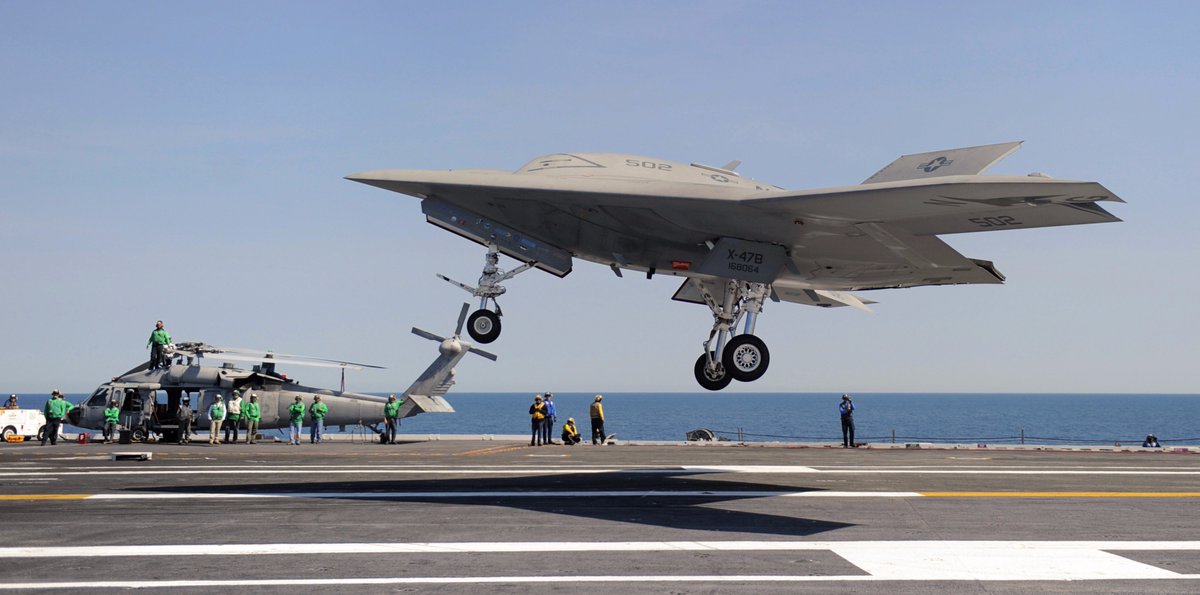Jura The idiot
General
This thread is about the new requirement that the US Navy has opened up for a drone Re-fueling tanker for its aircraft carriers.
Please direct posts regarding that aicraft, the competition for it, and the status to this thread.
What follows are several posts regarding it that had been posted on the X-47B Thread, which has dropped out of the competition and was a completely different requirement.:
--------------------------------------------------------------------
Vice Admiral David C. Johnson
had to say inside
article, in the part
The Sting With Stingray
The MQ-25 drone shows that, even if you use the new approach to acquisition, you don’t always get everything you want. As the Navy developed requirements for the unmanned, carrier-based refueling tanker, said Vice Adm. Johnson, it consulted intensively with the four competitors: Boeing, General Atomics, Lockheed Martin, and Northrop Grumman, which built the first carrier-launched drone, the X-47.
“The CNO (Chief of Naval Operations John Richardson) personally met with all four… twice,” Johnson told reporters. “When they got the RFP, it was not a mystery.”
When the Navy issued the final RFP, however, .
“Personally, Dave Johnson, yes, I was surprised that Northrop decided to back out,” Johnson admitted. “(But) we knew that they were worried about the RFP because we had really tooled it towards the tanker,” designed for long endurance but not high performance. Northrop’s X-47 and its subsequent work had been geared towards the earlier concept called UCLASS, Unmanned Carrier-Launched Surveillance & Strike, which was not a tanker but an attack aircraft. “It would have taken some redesign to keep it cost competitive, performance competitive,” Johnson said.
“It’s unfortunate. We thought they would stay in the competition,” he said, “but… we have three very capable folks still in.” Boeing and Lockheed are of course two of the biggest aerospace companies around, while General Atomics invented the iconic Predator drone. And Northrop Grumman, arguably, is better off knowing that MQ-25 was a bad fit for the company now, before it invested even more in winning it.
Johnson is optimistic about the MQ-25. The Navy will choose a winner by Oct. 1st next year, with the first operational unit (Initial Operating Capability) in 2024. That’s fast for an all-new aircraft, especially a carrier-based one, Johnson said. Once the award is made, though, he thinks the Navy and its chosen contractor will be able to “go even faster.”
Please direct posts regarding that aicraft, the competition for it, and the status to this thread.
What follows are several posts regarding it that had been posted on the X-47B Thread, which has dropped out of the competition and was a completely different requirement.:
--------------------------------------------------------------------
Vice Admiral David C. Johnson
had to say inside
article, in the part
The Sting With Stingray
The MQ-25 drone shows that, even if you use the new approach to acquisition, you don’t always get everything you want. As the Navy developed requirements for the unmanned, carrier-based refueling tanker, said Vice Adm. Johnson, it consulted intensively with the four competitors: Boeing, General Atomics, Lockheed Martin, and Northrop Grumman, which built the first carrier-launched drone, the X-47.
“The CNO (Chief of Naval Operations John Richardson) personally met with all four… twice,” Johnson told reporters. “When they got the RFP, it was not a mystery.”
When the Navy issued the final RFP, however, .
“Personally, Dave Johnson, yes, I was surprised that Northrop decided to back out,” Johnson admitted. “(But) we knew that they were worried about the RFP because we had really tooled it towards the tanker,” designed for long endurance but not high performance. Northrop’s X-47 and its subsequent work had been geared towards the earlier concept called UCLASS, Unmanned Carrier-Launched Surveillance & Strike, which was not a tanker but an attack aircraft. “It would have taken some redesign to keep it cost competitive, performance competitive,” Johnson said.
“It’s unfortunate. We thought they would stay in the competition,” he said, “but… we have three very capable folks still in.” Boeing and Lockheed are of course two of the biggest aerospace companies around, while General Atomics invented the iconic Predator drone. And Northrop Grumman, arguably, is better off knowing that MQ-25 was a bad fit for the company now, before it invested even more in winning it.
Johnson is optimistic about the MQ-25. The Navy will choose a winner by Oct. 1st next year, with the first operational unit (Initial Operating Capability) in 2024. That’s fast for an all-new aircraft, especially a carrier-based one, Johnson said. Once the award is made, though, he thinks the Navy and its chosen contractor will be able to “go even faster.”
Last edited by a moderator:


/arc-anglerfish-arc2-prod-mco.s3.amazonaws.com/public/IJFHGR3XHBE3RJMTLJYIDA67HM.jpg)